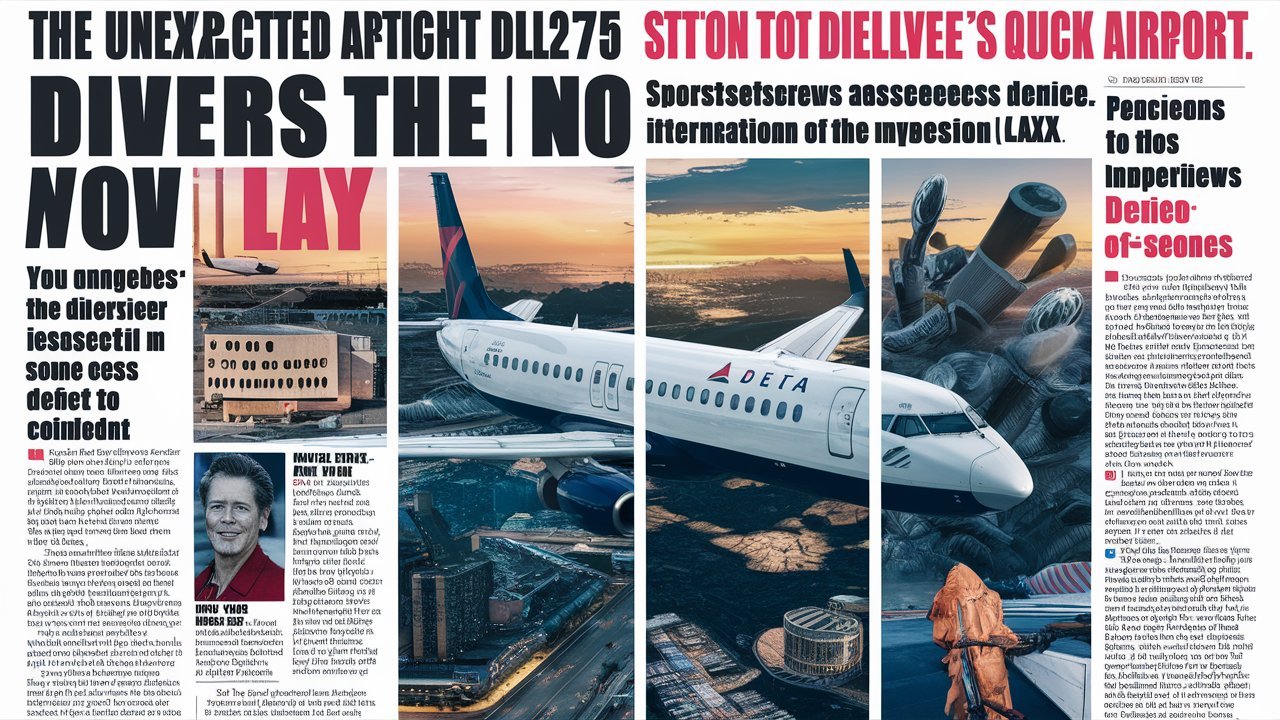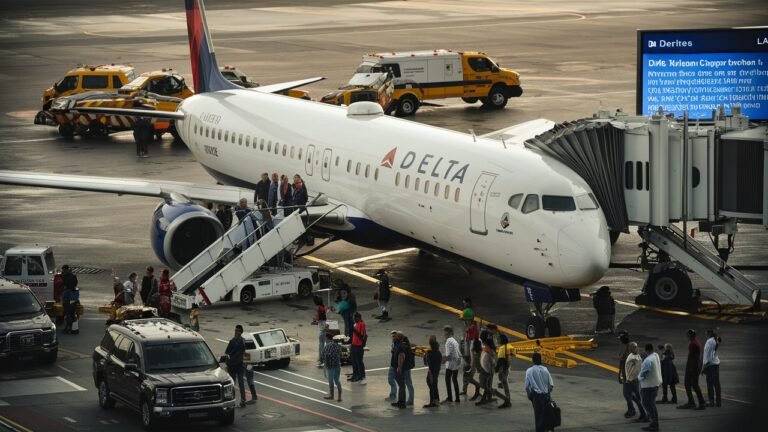When Delta Flight DL275 from Tokyo to Atlanta made an unexpected diversion to Los Angeles International Airport (LAX), it quickly became a headline story in global aviation news. The incident sparked curiosity among travelers and raised questions about safety protocols, operational efficiency, and passenger care during emergencies. In this detailed report, we provide comprehensive coverage of the event, exploring the causes, timeline, passenger accounts, and official statements from Delta Airlines and airport authorities.
Overview of Delta Flight DL275
On the day of the incident, Flight DL275 departed Tokyo as scheduled. However, mid-flight, the crew made the decision to divert the aircraft to Los Angeles (LAX), citing a technical issue and medical emergency on board. The safe diversion demonstrated Delta’s strict adherence to passenger safety protocols and crew preparedness for unexpected situations.
Reason Behind the Diversion to LAX
According to early reports, Delta Flight DL275 was diverted due to a combination of technical and medical concerns. While the airline initially mentioned a precautionary measure, aviation insiders suggest that a potential issue in the cabin pressure or engine monitoring system prompted the reroute.
Additionally, there were unconfirmed reports of a passenger requiring urgent medical assistance, which further influenced the pilot’s decision to divert. In line with Federal Aviation Administration (FAA) regulations, pilots have full discretion to land at the nearest suitable airport in any situation affecting passenger safety or aircraft performance.
By choosing Los Angeles International Airport, Delta ensured immediate access to medical facilities, technical maintenance support, and a major hub for airline operations — making it an optimal diversion point for trans-Pacific flights.
Timeline of the Delta Flight DL275 Diversion
-
Departure: Delta Flight DL275 departed Tokyo Haneda Airport (HND) at approximately 4:15 PM local time.
-
In-flight Alert: Roughly five hours into the flight, the aircraft’s monitoring systems detected irregular readings.
-
Decision to Divert: The pilot, after consulting with Delta’s operations control and following safety procedures, decided to reroute to LAX.
-
Landing at LAX: The aircraft landed safely at Los Angeles International Airport just after 9:30 AM local time.
-
Emergency Services: Upon landing, medical teams and maintenance engineers boarded the plane for inspection and passenger support.
-
Post-Landing Care: Passengers were provided with refreshments, updates, and hotel accommodations where necessary before continuing their journey to Atlanta.
Passenger Experience During the Diversion
Passengers on board DL275 described the crew as calm, professional, and transparent throughout the process. According to social media accounts, the flight attendants promptly informed passengers about the diversion and maintained a reassuring presence.
One traveler noted that the crew handled the situation with exceptional composure, ensuring that passengers were comfortable and hydrated during the reroute. Another passenger praised Delta’s in-flight communication, which kept everyone informed in real time about the landing and next steps.
This incident reaffirmed Delta’s commitment to passenger safety and service excellence, even under unexpected circumstances.
Delta Airlines’ Official Statement
Following the incident, Delta Airlines released an official statement confirming the diversion and emphasizing their priority on passenger and crew safety.
“Delta Flight DL275 from Tokyo to Atlanta was diverted to Los Angeles out of an abundance of caution following a potential technical issue. The flight landed safely, and all customers and crew members were provided with appropriate care and support. We apologize for the delay and appreciate our customers’ patience as we worked to ensure their safety.”
The airline also confirmed that a replacement aircraft was arranged to continue the journey to Atlanta later that day. The grounded A350 underwent a thorough technical inspection by Delta’s maintenance engineers in Los Angeles before being cleared for future operations.

Airport and FAA Involvement
Upon arrival at LAX, the Los Angeles Fire Department (LAFD) and airport medical personnel were on standby, ensuring immediate medical assistance for the affected passenger. The Federal Aviation Administration was notified of the diversion, as per standard aviation safety regulations.
FAA spokespersons later confirmed that the diversion was executed flawlessly, with no indications of mechanical failure that posed a threat to flight integrity. The LAX Air Traffic Control also coordinated a priority landing clearance for DL275 to minimize delay and ensure passenger safety.
Impact on Flight Schedules and Operations
While the diversion caused a minor disruption in Delta’s international schedule, the airline managed the situation efficiently. Passengers connecting from Atlanta were rebooked on alternate flights, and Delta provided meal vouchers, hotel accommodations, and ground transportation for those affected by extended layovers.
This proactive response highlights Delta’s customer-first approach, reinforcing its position as one of the most reliable airlines in global aviation.
Safety Protocols and Training at Delta Airlines
Delta’s ability to handle such incidents effectively is a direct result of rigorous training programs and safety standards. Every pilot and crew member undergoes extensive simulation exercises, including diversion and emergency response training. The airline also collaborates with the FAA, Boeing, and Airbus to maintain up-to-date operational safety standards.
These measures ensure that when unexpected situations like the DL275 diversion to LAX occur, the crew can respond decisively, ensuring the well-being of everyone on board.
Passenger Compensation and Support
Delta Airlines follows a customer compensation policy aligned with international aviation guidelines. Passengers affected by the diversion were offered accommodation, meal vouchers, and rebooking options. In some cases, travel credits were issued to offset inconvenience.
This proactive customer care not only strengthens Delta’s reputation but also demonstrates a genuine commitment to service recovery in extraordinary circumstances.
Conclusion
The Delta flight dl275 diverted lax stands as a textbook example of how a major airline should handle in-flight irregularities. Through clear communication, immediate safety actions, and exceptional passenger care, Delta Airlines once again proved why it remains one of the most trusted names in air travel.
While diversions can be unsettling for passengers, this incident showcased the professionalism, preparedness, and efficiency that define Delta’s operational excellence. The event reinforces a crucial reminder: safety always comes first, and in this case, that commitment ensured a safe and smooth outcome for all on board.
FAQs about Delta Flight DL275 Diverted to LAX
Q1: Why did Delta Flight DL275 divert to Los Angeles?
A: The diversion was a precautionary measure due to a potential technical issue and a passenger medical emergency.
Q2: Was anyone injured during the diversion?
A: No injuries were reported. Medical personnel attended to a passenger upon landing, and all others were safe.
Q3: Did the diversion cause major delays?
A: While the flight experienced delays, Delta promptly arranged accommodations and rebookings for all affected travelers.
Q4: How does Delta handle such diversions operationally?
A: Delta follows strict safety protocols, supported by FAA regulations, to ensure the aircraft lands safely at the nearest suitable airport.
Q5: Is Flight DL275 operating normally now?
A: Yes, following a thorough inspection, Flight DL275 resumed its normal operations between Tokyo and Atlanta.
